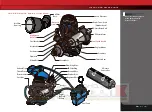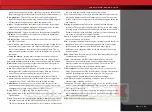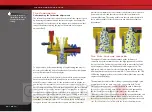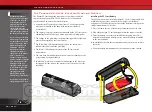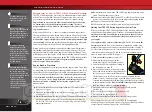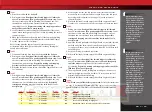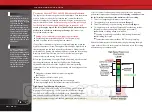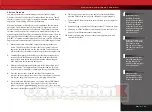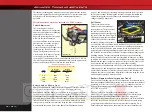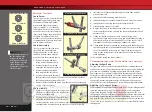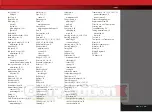
32 • Revo
The TRX 2.5R Racing Engine
Winter Break-in Tips
During the break-in process, the piston and sleeve wear into each other to
form a precise fit. The engine needs to heat up to a temperature around
200 to 215 degrees to allow the piston and sleeve to achieve this fit
properly. A precise fit between these two components is critical for proper
compression, and optimum performance. If the engine runs too cold during
break-in, the piston and sleeve will not expand to their appropriate sizes for
break-in, and this can lead to premature wear of these components. This
wear may not become apparent until after winter has past, and the engine
is operated under warmer running conditions.
Warm the engine to approximately room temperature with a heat gun,
or keep the vehicle inside at room temperature just before starting the
engine. The engine can become difficult to start in cold weather.
After the engine is running, it is important to keep the temperature of
the engine up around 200 to 215 degrees during break-in. In weather
below 45 degrees, the TRX 2.5R Racing Engine will tend to run at lower
temperatures between 160 to 180 degrees (when tuned at proper
break-in mixture settings). This is too cool for break-in.
Do not lean the
engine to increase engine temperature!
This will also decrease
lubrication and cause your piston/sleeve to wear prematurely.
Wrap the cooling head with a paper
towel, clean rag or sock to help keep the
engine running around the
recommended 200 to 215 break-in temp.
If too much heat is contained, the engine
can actually run too hot. Make sure that
you monitor the engine's temp closely for
the first couple of tanks until you get the
right amount of cover for the cooling
head. This will, of course, depend on your current weather conditions.
Adjusting the cover up and down, exposing more or fewer cooling fins,
is a convenient way to regulate engine temps.
For owners that do not have access to a temperature probe, a drop of
water on the cooling head (around the glow plug area) should slowly
sizzle for approximately 6 to 8 seconds around 200 to 210 degrees. If the
water sizzles for only a few seconds, then it is likely that it is over 220
degrees, and needs to cool down. If the water takes a long time or does
not evaporate at all, then the engine is too cool.
We do not recommend that you operate your engine below 35 degrees
Fahrenheit. If you insist on running your vehicle below 35 degrees, just
make sure you are aware that nitro engines may be very difficult to start
and tune at those extremely cold temperatures. Also, at temperatures
below freezing, nitro fuel can actually begin to gel up, and this can be
harmful to the engine.
Follow the remaining break-in procedures as outlined in this owner's
manual. This, along with the steps listed above, will ensure a good break-in
for your new nitro engine, and provide many hours of enjoyment.
Tuning the Engine by Temperature
The following procedures require an
optional infrared temperature probe or
on-board temperature gauge (Traxxas
on-board digital temperature gauge, part
#4090 or #4091). Engine temperature can
be used as an effective tuning aid when you
understand the relationship between engine temperature and ambient
temperature. The engine operating temperature, when tuned for maximum
performance, will vary according to atmospheric conditions. The
atmospheric condition that has the most influence on engine temperature
is air temperature. Expect the engine temperature to vary almost in direct
proportion to air temperature. Assuming you tuned the engine for the
same maximum performance each day, the engine will run about twenty
degrees hotter when it’s ninety degrees outside than it would in seventy-
degree weather. For this reason, we cannot give you a definitive
temperature range that indicates the best possible engine tuning.
The temperature gauge can aid you in tuning by giving you a relative
indication of how your adjustments are affecting the engine and by
preventing you from exceeding maximum engine temperature. For
example, as you lean the fuel mixture, the engine performance will increase
along with the temperature. If you continue to lean the fuel mixture and
the temperature increases but the engine performance does not change,
then you have exceeded the maximum safe lean setting.
Even if it’s 100°F outside, you should be able to tune for maximum
performance. Try to keep your engine from exceeding 270°F when
measured at the glow plug. If tuning for maximum performance results in
engine temperature exceeding 270°F, try to increase airflow to the engine
by cutting out the rear of the body, windshield, and front valance. If the
engine temperature still cannot be kept below 270°F, richen the high-speed
needle slightly.


